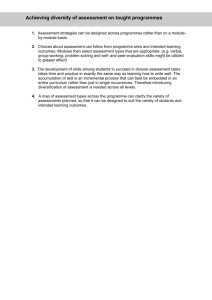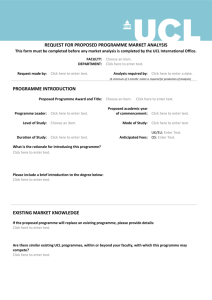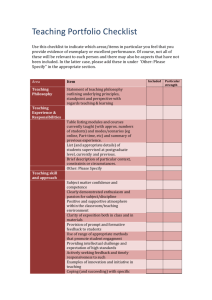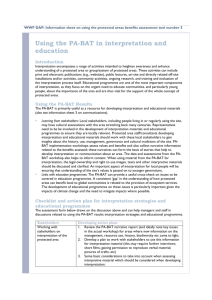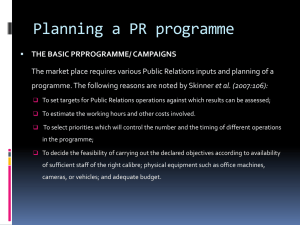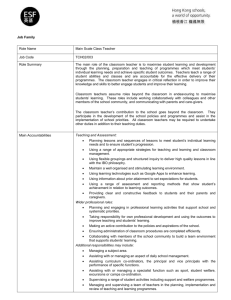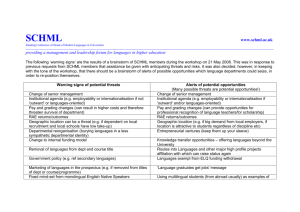Programme Proposal Guidance: Rationale & Format
advertisement
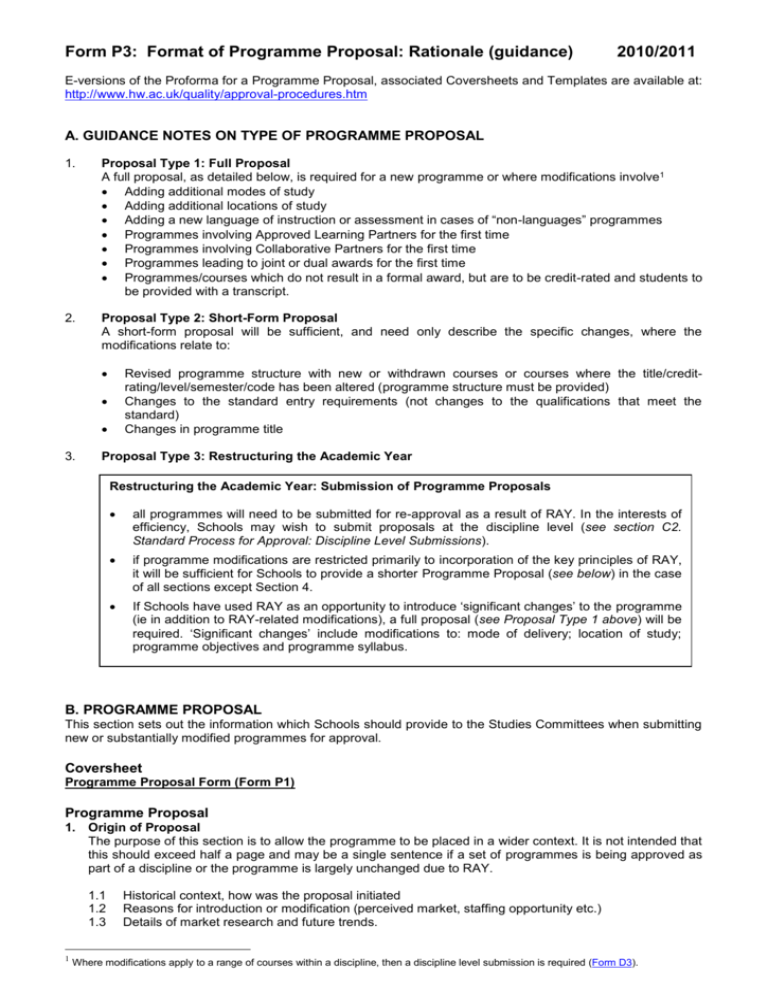
Form P3: Format of Programme Proposal: Rationale (guidance) 2010/2011 E-versions of the Proforma for a Programme Proposal, associated Coversheets and Templates are available at: http://www.hw.ac.uk/quality/approval-procedures.htm A. GUIDANCE NOTES ON TYPE OF PROGRAMME PROPOSAL 1. Proposal Type 1: Full Proposal A full proposal, as detailed below, is required for a new programme or where modifications involve1 Adding additional modes of study Adding additional locations of study Adding a new language of instruction or assessment in cases of “non-languages” programmes Programmes involving Approved Learning Partners for the first time Programmes involving Collaborative Partners for the first time Programmes leading to joint or dual awards for the first time Programmes/courses which do not result in a formal award, but are to be credit-rated and students to be provided with a transcript. 2. Proposal Type 2: Short-Form Proposal A short-form proposal will be sufficient, and need only describe the specific changes, where the modifications relate to: Revised programme structure with new or withdrawn courses or courses where the title/creditrating/level/semester/code has been altered (programme structure must be provided) Changes to the standard entry requirements (not changes to the qualifications that meet the standard) Changes in programme title 3. Proposal Type 3: Restructuring the Academic Year Restructuring the Academic Year: Submission of Programme Proposals all programmes will need to be submitted for re-approval as a result of RAY. In the interests of efficiency, Schools may wish to submit proposals at the discipline level (see section C2. Standard Process for Approval: Discipline Level Submissions). if programme modifications are restricted primarily to incorporation of the key principles of RAY, it will be sufficient for Schools to provide a shorter Programme Proposal (see below) in the case of all sections except Section 4. If Schools have used RAY as an opportunity to introduce ‘significant changes’ to the programme (ie in addition to RAY-related modifications), a full proposal (see Proposal Type 1 above) will be required. ‘Significant changes’ include modifications to: mode of delivery; location of study; programme objectives and programme syllabus. B. PROGRAMME PROPOSAL This section sets out the information which Schools should provide to the Studies Committees when submitting new or substantially modified programmes for approval. Coversheet Programme Proposal Form (Form P1) Programme Proposal 1. Origin of Proposal The purpose of this section is to allow the programme to be placed in a wider context. It is not intended that this should exceed half a page and may be a single sentence if a set of programmes is being approved as part of a discipline or the programme is largely unchanged due to RAY. 1.1 1.2 1.3 1 Historical context, how was the proposal initiated Reasons for introduction or modification (perceived market, staffing opportunity etc.) Details of market research and future trends. Where modifications apply to a range of courses within a discipline, then a discipline level submission is required (Form D3). 2. Aims and Objectives The aim of this section is to explain the overall objectives of the programme and how it fits with the School and University objectives. There should be references to School strategies, forward plans etc. For programmes that are being revised as part of RAY, this may be a short section and should not normally exceed 1 page. 2.1 2.2 2.3 2.4 2.5 2.6 Clear statement of aims and expected learning outcomes Compatibility with overall School strategic plans Alignment with University’s mission statement and strategy Target student numbers Target employment sector(s) Statement on equal opportunities (race, gender and disability) and identification of related issues. 3. Programme management and general information The purpose of this section is to explain how the programme is managed. All aspects of management should be covered including: recruitment of students; curriculum development, monitoring and evaluation; relationships with Professional and Statutory Bodies; management of academic standards. This section may be common for all programmes in a discipline or even across the School as a whole, in which case a standard section may be appended to the Programme Proposal. It is likely that this section will not exceed 2 pages for conventional programmes running on the Home Campus. Where other modes of delivery or locations of study are being considered for approval, then this section will be longer and include issues such as the management of quality in partners (Approved Learning Partners, Collaborative Partners), induction and ongoing support for Approved Learning Partner staff and monitoring of the progress of off-campus students. 3.1 3.2 3.3 3.4 3.5 3.6 3.7 Recruitment policy and entry qualifications Programme management structure including committee(s), industrial or business input Accreditation by professional and other bodies Proposed publicity methods External examiners Quality assurance, including Collaborative and Approved Learning Partners, Approved Teachers & Tutors, managing off-campus students Timetabling and staff-student contact if not standard (eg block teaching). Requirements for Approved Learning Partners relating to staff competences, facilities etc should be produced on a separate page so that the information can be included as part of the documentation required for approval of an Approved Learning Partner. 4. Programme Description The purpose of this section is to ensure that the programme curriculum is at present, and likely to remain, current, coherent and complete, and that the programme meets the University expectations as set out in the RAY Curriculum Structure Guidelines, particularly research-informed learning and employability & professional career readiness (EPCR) (objectives at 2007). It is likely that this section will be about 2-4 pages long. Where aspects of the curriculum such as the development of research-informed learning or the development of EPCR skills are common across a discipline or even across the School as a whole, then they may be prepared as a separate Appendix so that they can be reused for other programmes. 4.1 4.2 4.3 4.4 4.5 4.6 Outline of the programme Processes for developing the programme and for ongoing evaluation to ensure that the programme curriculum is current, coherent and complete. References to Benchmark Statements and other external reference points should be included. There should be an explicit statement of the compliance of the programme and its awards with the credit and level requirements of the Scottish Credit and Qualifications Framework (SCQF) Activities to ensure effective transition to University for new students Development of research-informed learning skills throughout the programme Development of employment-related skills (inc PDP) throughout the programme Consideration of the international dimension to student learning, the curriculum and wider experience 5. Resource Implications and Costing The purpose of this section is to ensure that the School has the resources and academic, administrative and managerial expertise to deliver the programme. Where this is a conventional programme delivered at the Home Campus, then this section may be short. Where the programme is to be delivered by nonconventional methods or outside the Home Campus, then this section needs to be more substantial. 5.1 Staffing skills necessary for the delivery of the programme. This is mainly intended for programmes to be delivered outside the Home Campus or by non-traditional methods (e.g. blended learning) 5.2 5.3 5.4 5.5 5.6 5.7 5.8 5.9 5.10 5.11 5.12 5.13 Special staff development that will be required to deliver the programme (e.g. development of VLE skills) Likely involvement of external staff Any necessary additional staffing (academic, part-time, support, administrative) and confirmation that these staff costs are included in forward School budgets Operational efficiency (including, where appropriate, service teaching requirements) Issues concerning funded numbers, research studentships Requirements for, and any limitations arising from restrictions in, physical space, teaching room and laboratory availability Special facilities (e.g. labs - not computers and library) required at any Approved Learning Partner or Partner where the programme is to be delivered outside the Home Campus. Concerns or special issues regarding Library and computing facilities Fees (including any fee differentials) as at time of submission Costing analysis, anticipated net income Sources for start-up costs (if first year(s) in deficit) Compliance with financial outline in School strategic plan. 6. Any Other Relevant Information Schools should identify here any additional information that might be relevant. 7. Programme Structure 7.1 A clear outline (with diagrams if helpful) of the discipline which the programme is part and of courses, electives etc. 7.2 The Standard Programme Structure/Notes/Description templates should be included (Note: there are different forms for undergraduate and postgraduate programmes) 8. A Summary of the Proposal for Senate 8.1 A one or two paragraph summary of the programme proposal to be forwarded to Senate if proposal is approved.
